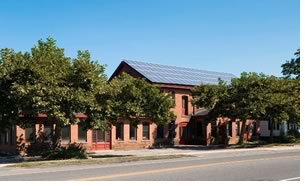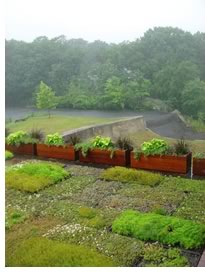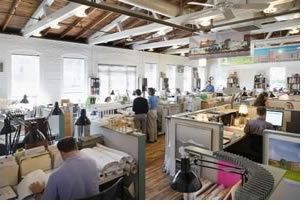

3/2006
Architects turn their office into “mini-electric power plant”

by Tracy Ostroff
True to its history of using its own historic 19th-century building as a “laboratory for environmentally sustainable design,” Centerbrook Architects recently installed the largest corporate solar-energy project in Connecticut. A rooftop on Centerbrook’s office has been turned into a mini-electric power plant, with 100 solar photovoltaic (PV) panels converting sunlight directly into non-polluting electricity. The solar-energy system joins many other “green” installations at the 20,000-square-foot office sited on the Falls River, including a hydropower plant. Together with the PV panels, Centerbrook expects to generate about 20 percent of its annual electrical needs and thus save $8,000 annually on electric bills. U. S. Sen. Joseph Lieberman launched the solar-energy project in a dedication ceremony held at Centerbrook February 21.
 Having
designed with solar power since the 1970s, Centerbrook’s
principals are hardly shocked that solar power is “in” as
a viable source of electricity, now that energy prices are high again. “We’ve
always been interested in this, but now suddenly the payback, which used
to be somewhere in the neighborhood of 30 years to recapture your initial
costs, is now down to 5 or 6 years,” explains Centerbrook Partner
William H. Grover, FAIA, thanks to new government incentives.
Having
designed with solar power since the 1970s, Centerbrook’s
principals are hardly shocked that solar power is “in” as
a viable source of electricity, now that energy prices are high again. “We’ve
always been interested in this, but now suddenly the payback, which used
to be somewhere in the neighborhood of 30 years to recapture your initial
costs, is now down to 5 or 6 years,” explains Centerbrook Partner
William H. Grover, FAIA, thanks to new government incentives.
Two programs have helped make solar power more practical for some projects. One is the Connecticut Clean Energy Fund (CCEF), which provides grants for the construction of non-polluting sources of electricity and energy. Second, Grover notes, the federal government recently passed an act giving a tax credit for generators of non-polluting energy, which Grover says equates to about 30 percent of the cost of the system. Together, these subsidies are paying for 67 percent of the total construction cost of the Centerbrook project.
 The timing is right
The timing is right
Centerbrook uses a 16.5 kilowatt system that provides about 20,600 kilowatt-hours
of electricity annually, or about 10 percent of the building’s
electrical needs. This is the equivalent to reducing emissions of 34
pounds of nitrogen oxides, 85 pounds of sulfur dioxide, and 20,183
pounds of carbon dioxide annually. Connected directly to the electric
utility’s power grid, the system does not require any storage
batteries.
Costwise, the breakdowns for the project are:
- Average cost of electricity at this time is approximately .1255¢ per kWh
- Estimated annual cost savings from solar photovoltaic system: $4,000
- Total installed cost (materials and labor) of solar photovoltaic system: $141,500
- Subsidy from Connecticut Clean Energy Fund: -$74,550
- 2006 Federal Tax Credit in National Energy Plan: -$20,100
- Net cost of solar photovoltaic system to Centerbrook Architects: $46,850.
 “Between our hydro plant and our solar system, this year so far
we’ve generated about $2,000 of electricity since the first of
January,” Grover says. “Our objective, in the long run—through
conservation, techniques for using less energy, and photovoltaics and
other systems—is to get ourselves to a net zero. The object is
going to be a tough one to meet, but I think over the years we can do
it.” As a next step, Centerbrook is planning another 22 kilowatts
of solar panels on a west-facing roof of their complex by mid-summer.
Grover says the firm is also planning for photovoltaic systems on a number
of projects for various clients. “About 75 percent of our work
is for repeat clients. I noticed that those who three years ago would
not have considered photovoltaics are considering them now.”
“Between our hydro plant and our solar system, this year so far
we’ve generated about $2,000 of electricity since the first of
January,” Grover says. “Our objective, in the long run—through
conservation, techniques for using less energy, and photovoltaics and
other systems—is to get ourselves to a net zero. The object is
going to be a tough one to meet, but I think over the years we can do
it.” As a next step, Centerbrook is planning another 22 kilowatts
of solar panels on a west-facing roof of their complex by mid-summer.
Grover says the firm is also planning for photovoltaic systems on a number
of projects for various clients. “About 75 percent of our work
is for repeat clients. I noticed that those who three years ago would
not have considered photovoltaics are considering them now.”
Integrating PV design
“We happen to have a building that has a south-facing surface at
a nice angle to the sun and an ideal location for the solar collectors,” Grover
says of the Centerbrook offices. “When people come to our office,
I’ll ask, ‘Did you notice our solar array on the outside of
the building,’ and mostly they say ‘no.’ If you’re
not looking for it, you don’t notice it, and that’s the way
a good solar array ought to be.”
“I don’t happen to find photovoltaic panels themselves unpleasant to look at,” Grover says. “I think they look unpleasant if you put up six or eight panels and they don’t cover existing roof and don’t fit in with the building’s architecture. In other words, it looks bad if it’s just slapped on the roof like a band-aid. That’s given solar panels a bad name.” Grover says, “Our job is to integrate the photovoltaic panels into the building design so it looks like a natural part of the building.”
 While PV panels are getting cheaper to manufacture, and their efficiency
is improving, Grover advises not to expect improvements by leaps and
bounds in their efficiency. “The efficiency is such that 16 or
17 percent of the energy that falls onto that panel gets converted into
electricity. I would say a practical maximum for the next 10 or 15 years
may be 20 percent, but that’s something we can’t predict.
It depends a lot on how much it costs to make them. If you have a very
inexpensive panel, but it makes 17 percent, then that is probably worth
it. Part of our objective is to popularize photovoltaic panels on buildings
so that production will go up and costs will go down.”
While PV panels are getting cheaper to manufacture, and their efficiency
is improving, Grover advises not to expect improvements by leaps and
bounds in their efficiency. “The efficiency is such that 16 or
17 percent of the energy that falls onto that panel gets converted into
electricity. I would say a practical maximum for the next 10 or 15 years
may be 20 percent, but that’s something we can’t predict.
It depends a lot on how much it costs to make them. If you have a very
inexpensive panel, but it makes 17 percent, then that is probably worth
it. Part of our objective is to popularize photovoltaic panels on buildings
so that production will go up and costs will go down.”
Centerbrook is collecting and monitoring their energy use from the solar- and hydro-power installations. Soon they will have a comprehensive system that shows how much energy they use, what times of day they use it, how much they generate, and when they generate it. They will use this information, Grover says, to assess when and how much demand their office places on the power grid. “If we use a huge amount of energy over a period of a few hours, it changes our rates, so it makes sense for us to figure out ways to balance it so that we don’t have a high demand.” The information will ultimately be available on a public Web site off the architect’s homepage.
The bottom line is the bottom line
Clients’ interest in solar energy has many sources. “As we
require more energy, we have to generate more electricity and therefore
build more power plants. Not only is building the power plants expensive,
the majority of the electrical energy produced in the United States is
produced from coal, a polluting energy source,” Grover says. “Secondarily,
the distribution of this electricity that they generate in a coal-fired
plant has to go over the power lines, and power lines in the Northeast
have to go over densely-populated areas. Energy is available from various
places, but they can’t get it from one place to another because
people don’t want power lines in their backyards.”
 “Most of our clients are nonprofit organizations and they have
to look at the cost of energy when they’re building their projects.
The federal tax credit does not apply to them because they already don’t
have to pay taxes. But something like the Connecticut Clean Energy Fund,
which actually subsidizes the installation of photovoltaic cells, is
attractive to them,” Grover notes. “Most of them are educational
institutions that want to be seen as people who are in favor of green
energy and sustainable design. It’s good publicity for them because
students are interested in that. It also ends up saving them money.”
“Most of our clients are nonprofit organizations and they have
to look at the cost of energy when they’re building their projects.
The federal tax credit does not apply to them because they already don’t
have to pay taxes. But something like the Connecticut Clean Energy Fund,
which actually subsidizes the installation of photovoltaic cells, is
attractive to them,” Grover notes. “Most of them are educational
institutions that want to be seen as people who are in favor of green
energy and sustainable design. It’s good publicity for them because
students are interested in that. It also ends up saving them money.”
But the real impetus, Centerbrook has found, is that every time the price of oil goes up, people suddenly get interested. “We found this in the 1970s when there was a big spike in oil prices. We designed a lot of solar heated houses and a number of larger solar heated buildings. Then the price of fuel leveled off and went down—and everybody forgot about it and bought big SUVs,” Grover says “Suddenly, the price of oil is going up and we’re realizing that our dependency on oil cannot be solved by anything other than thinking of new ways to generate electricity. Conservation will help, but it won’t solve the whole puzzle.”
Copyright 2006 The American Institute of Architects.
All rights reserved. Home Page ![]()
![]()
Centerbrook’s property, sited on the Falls River, has been a water-powered industrial site since 1721. Centerbrook’s renovations included the installation of a new hydropower plant in the building in 1982. Today, hydropower generates approximately 10 percent of Centerbrook’s electrical needs.
As part of its ongoing research into sustainable building practices,
Centerbrook installed a “green” roof over a portion of its
office. The roof serves the staff as an on-site experiment into the suitability
of a variety of plants as roofing material. Green roofs reduce air pollution
and help control heating and cooling costs.
(Source: Centerbrook Architects)
Visit the Connecticut Clean Energy Fund Web site. ![]()
Visit the federal National Energy Plan Web site. ![]()
![]()